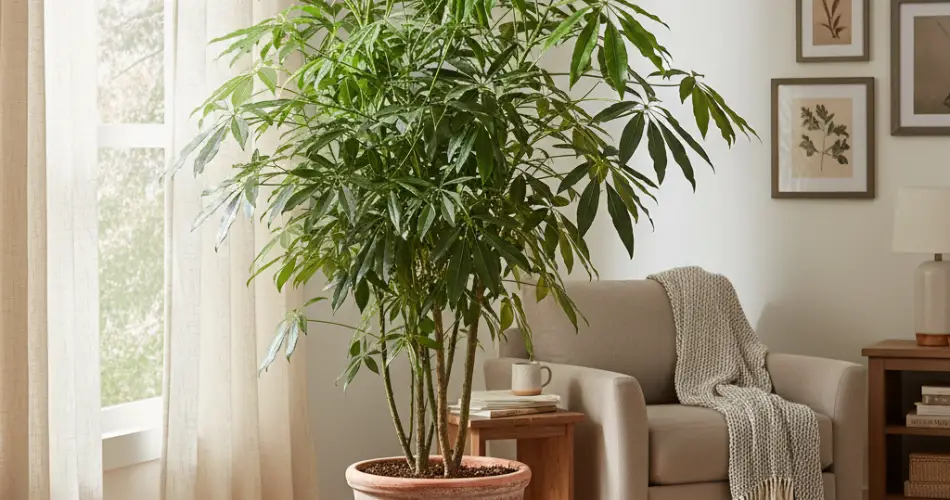The umbrella tree (Schefflera arboricola) is a striking and versatile houseplant, admired for its glossy, umbrella-like leaves arranged in radial clusters. Its lush foliage, upright growth habit, and ease of care make it a favorite choice for homes, offices, and indoor gardens. While umbrella trees are adaptable and resilient, light is one of the most crucial factors influencing their growth, leaf color, and overall health.
Understanding whether umbrella trees prefer shade or bright light ensures strong stems, vibrant foliage, and a well-proportioned shape, preventing common issues like yellowing leaves or leggy growth.
Natural Habitat and Light Adaptation
Umbrella trees are native to Taiwan and Hainan in China, where they grow in tropical and subtropical forests. In their natural habitat, they thrive in filtered sunlight, often beneath the canopy of taller trees. This exposure allows them to tolerate lower light levels while benefiting from indirect brightness to support healthy, vigorous growth. Their adaptability to varying light conditions explains why umbrella trees are well-suited for indoor environments.
Bright, Indirect Light: Ideal Conditions
Umbrella trees flourish in bright, indirect light, which promotes healthy leaf growth, maintains vibrant green coloration, and supports a dense, bushy form. Bright light encourages new leaf development and prevents stems from elongating excessively, keeping the plant compact and visually appealing.
Indoor placement tips for bright, indirect light:
-
East-facing windows: Provide gentle morning sunlight that stimulates steady growth.
-
North-facing windows: Offer moderate light for consistent development without risking leaf burn.
-
South- or west-facing windows with sheer curtains: Filter harsh rays to protect delicate foliage.
With bright, indirect light, umbrella trees develop dense, glossy foliage and maintain their characteristic umbrella-shaped leaf clusters, enhancing their decorative appeal.
Low Light Tolerance
One of the reasons umbrella trees are popular for indoor spaces is their ability to tolerate low-light conditions. This makes them suitable for offices, hallways, or rooms with minimal sunlight.
In low-light environments, you may notice:
-
Slower growth and fewer new leaves.
-
Darker green leaves, which may reduce the plant’s visual vibrancy.
-
Slight elongation of stems as the plant stretches toward the nearest light source.
While umbrella trees survive in shade, they perform best when exposed to brighter, filtered light. Supplementing with artificial lighting or occasional relocation to a brighter spot can maintain optimal growth and leaf coloration.
Direct Sunlight: What to Avoid
Although umbrella trees enjoy brightness, direct sunlight can damage the plant. Harsh sun, particularly from south- or west-facing windows, may scorch leaves, leaving brown tips, faded patches, or curled foliage.
To protect the plant:
-
Position it several feet away from direct sunlight.
-
Use sheer curtains to filter strong rays.
-
Gradually acclimate the plant if moving from a shaded area to a brighter location.
Avoiding direct sun ensures the plant retains its glossy leaves and prevents long-term damage.
Outdoor Light Considerations
In suitable climates, umbrella trees can be grown outdoors. They prefer partial shade or dappled sunlight, which mimics their natural understory habitat.
Outdoor placement tips:
-
Morning sun is generally safe, while harsh afternoon sunlight should be avoided.
-
Place under taller plants or shade structures for filtered light.
-
Avoid full, direct sun, especially during hot afternoons, to prevent frond scorch.
Acclimating indoor-grown umbrella trees to outdoor light gradually prevents stress and sunburn.
Artificial Lighting for Indoor Growth
If natural light is limited, umbrella trees thrive under artificial lighting. Fluorescent or LED grow lights provide sufficient intensity to maintain healthy growth and vibrant leaves.
Tips for artificial lighting:
-
Use full-spectrum lights to replicate natural sunlight.
-
Position the light 12–18 inches above the plant.
-
Provide 10–12 hours of light per day to ensure steady growth.
Artificial lighting is particularly helpful in offices, interior rooms, or during winter months when daylight is limited.
Seasonal Adjustments
Lighting requirements may change with the seasons:
-
Summer: Protect from intense afternoon sun, especially near bright windows.
-
Winter: Place closer to a bright window or supplement with artificial lighting to compensate for shorter daylight hours.
Rotating the plant occasionally ensures even growth and prevents stems from leaning toward the light source.
Signs of Incorrect Light
Umbrella trees show clear signs when light conditions are not ideal:
-
Too little light: Slower growth, small or fewer leaves, and leggy stems.
-
Too much direct light: Scorched leaves, brown tips, and faded foliage.
-
Optimal light: Dense, bushy growth with glossy, vibrant leaves.
Monitoring these signs allows you to adjust the plant’s placement to maintain optimal health and appearance.
Final Thoughts
Umbrella trees are elegant, adaptable houseplants that thrive indoors under the right lighting conditions. While they tolerate shade, they perform best in bright, indirect light, which encourages strong growth, dense foliage, and healthy, vibrant leaves.
For optimal care, place your umbrella tree near east- or north-facing windows, filter south- or west-facing sunlight, or supplement with artificial lighting if natural light is insufficient. With proper light management, this versatile plant will provide lush, tropical greenery that enhances any indoor space, offering elegance and charm year-round.



